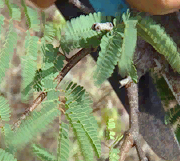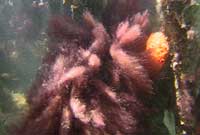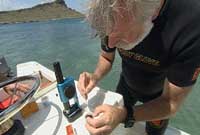Curacao - The Plants

Curaçao is an island in the southern Caribbean. Its arid, limestone terrain is harsh, at times almost desolate. Yet its sun-beaten, dry ecosystem may host vegetation that could hold some of the secrets for future medical cures. On land, the Divi Divi tree has shown a remarkable ability to fight staph infections. Under water, a local algae called Mermaid's Hair has proven to have strong, anti-cancer properties.
The Divi Divi

Leaves of Divi Divi plant
The Divi Divi tree in the Caesalpinia family and a relative to eucalyptus trees, is found only in the Caribbean. On Curaçao, it grows mostly around Christoffel Park. It has shown a remarkable ability to fight staph infections. Biologist John DeFreitas from a local institute called CARMABI (Caribbean Research & Management of Biodiversity) is working for further scientific understanding of this ancient medicinal plant.
View video: Biologist John DeFreitas Collecting the Divi Divi.
View video: DeFreitas in the Lab.
Mermaid's Hair

Mermaid's Hair underwater
Although Lyngbya majuscula or "Mermaid's Hair": is found in many Caribbean bays, for some reason still unknown to scientists, the Mermaid's Hair in Curaçao's Spanish Waters Bay produces an amazing and promising substance called Curacin A.
Mermaid's Hair is actually a giant bacteria. It grows underwater in the mangrove along the trellises. It has a fluffy reddish color underwater. Once taken to the "on board lab," it appears as blackish, matted fiber.
Under the microscope, the cells look like little pancakes or coins stacked into long filaments all encased in sheet-like material.

Dr. Bill Gerwick using microscope
It is really quite a remarkable organism, Oregon State University researcher Dr. Bill Gerwick first collected the blue-green algae here in December 1991. He named its medicinal compound Curacin A in honor of the island of Curaçao where he explored for compounds that might be useful to treat human diseases.
Dr. Gerwick says, "It's pretty amazing to think that an algae growing under a mangrove in a little bay in the west coast of Curaçao in the middle of the Caribbean could yield the compound that could be ultimately use to treat cancer."
View video: More of Dr. Bill Gerwick talking about the algae.
For more information about this website.
Contact the webmaster to report any problems with this site.
New Mexico State University is an equal opportunity/affirmative action employer and educator. NMSU and the U.S. Department of Agriculture cooperating.